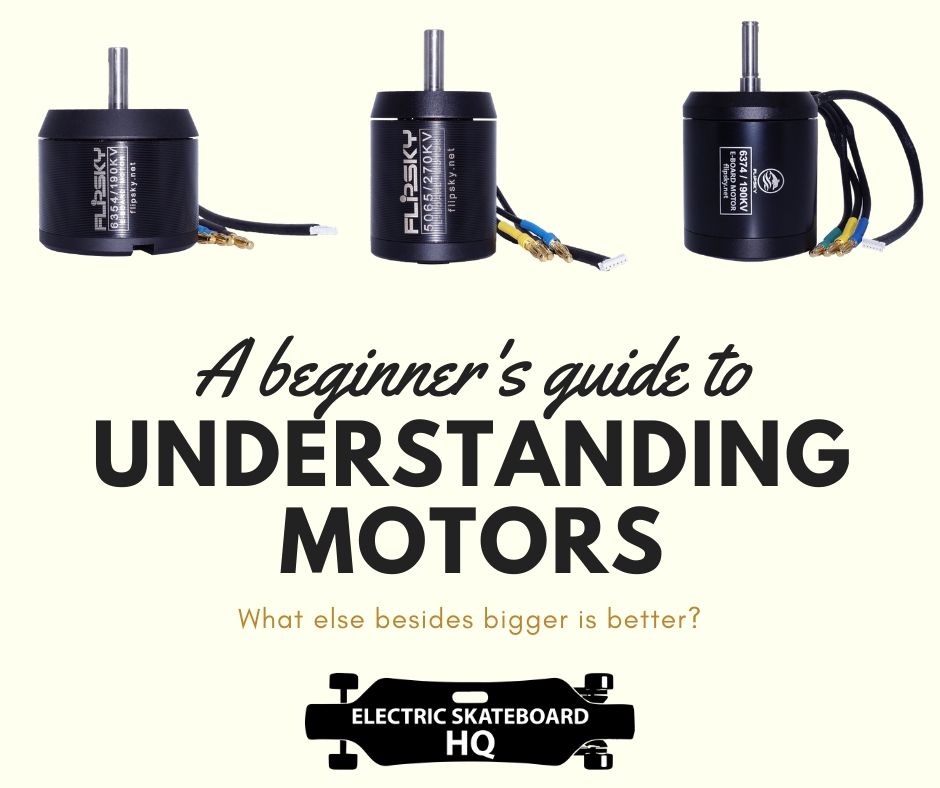While there are many types of motors (Outrunner, hub motors, direct drives), they operate on a similar basis, and once you understand one of them, you will know how each board compares and which motor to pick for your DIY build.
Outrunner Motors

Every motor stats
Eskate manufacturer and motor manufacturers always throw around a few specs; they are the Sizes, Kv, and Watts.

Size

The 4 digits of the motor denote the size of the motor. For example, the motor sample on the photo goes by 6384. It means 63mm in diameter and 84mm in length. This usually means the outer dimensions of the motor can itself; however, minor variations may occur due to can design.
Logic may dictate that a larger can size usually means a more powerful motor. However, the strength of the motor can come from a variety of many factors, such as internal construction methodology, type and shape of magnets used, airgap between the stator and can, and size of the stator itself.
It is usually a good idea to ask the manufacturer for the size of the actual stator itself instead of the motor can as that number in combination with the motor size is a better indicator of how powerful a motor is.
KV ratings
KV is the number of revolution per minute (rpm) that a motor gives when 1 volt is applied to the motor. That is when we let the motor spin freely without load. This means that the higher KV, the faster the motor spins. However, all other factors being equal, a higher KV also means a lower torque output.
The usual KV ratings found in an electric skateboard outrunner motor will range from 140KV to 220KV. This is different for a hub motor; however, as hub motors don’t have pulleys and gear reductions to final speed and torque. As such, they are usually much lower KV (80-100KV) to maintain comparable torque.
- Lower KV – higher torque, lower top speed
- Higher KV – lower torque, higher top speed
For example, Enertion Raptor 2, which is known to be torquest hub motor, has 85Kv, while generally hub motors have 100Kv.
Watts

As we all learned from high school, power is measured in Watts. And Watts is calculated by Voltage x Ampere. If you have a high wattage motor, meaning it can handle a lot more voltage and/or ampere, and this in turns means it can be more torquey or go faster.
In an electric skateboard world, the power of a motor can differ by a considerable number. A simple hub motor can only have a power of 250W or 350W each, but will still work pretty nicely. On the other hand, Enertion’s R-Spec Ghost, which is the most powerful hub motor on the market, has a power of 1680W each. (and it gulps down battery like nobody’s business)
Outrunner motor tends to have a higher power. The motor in production belt-driven eskate usually ranges around 600W each (Wowgo 3X) and those with AT wheels around 1500W (Ownboard AT).
For DIY, you can get motors ranging from 1000W to 4000W.
Ampere

Every motor has the maximum current it can pull. For example, 50A. You have to make sure the ESC max output is higher than the max current draw for the motor, by a small margin (5%). If the motor draws higher ampere than the ESC can provide, the ESC may be fried. Cutting it too close also hurts the longevity of the ESC.
So if your motors can draw 50A each (total 100A), make sure the ESC can support at least 5% above that, meaning 5% above 100A, meaning at least 105A. If you are using a VESC and can set the current limits, be sensible and make sure you don’t go over both the maximum motor current limits (this kills the motor) or the maximum limits of the VESC (this kills the VESC).
Voltage

Every motor specs will tell you what is the voltage that the motor supports. Generally, however, the voltage of the motor doesn’t matter too much as they usually support a very wide range of voltage – somewhere between 3s to 12s (4.8V-43.2V). (If you don’t understand specs of the battery, check out my comprehensive guide on the battery)
Sensored VS Unsensored motor
Some motors come with the sensor cable; some don’t.
Sensored motor allows the motor to detect the position of the motor at all times, which translates into a smoother start-up. Unsensored motor, on the other hand, often is jerky when starting from a standstill and often requires a kick push to have a smooth start.
Nowadays, practically every production board you can buy comes with sensored motor. And there is no reason to get an unsensored motor. By the way, a sensored motor will still work as an unsensored motor if you choose not to plug the sensor cable in.
For DIY-er, you probably should know that sensor cables are not all the same. Some come with 6 pins head (as it includes a temperature sensor wire), some only 5. You might need to change the pinhead yourself if the sensor wire doesn’t match with your ESC.

Where to get your motors:
There are a few places you can get your motors.
If you are buying any DIY part, do check out our “discount code” page as we might very well have affiliated discount code for some of them!




